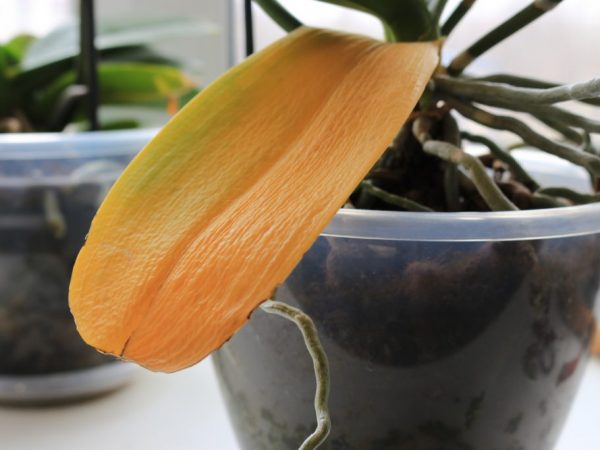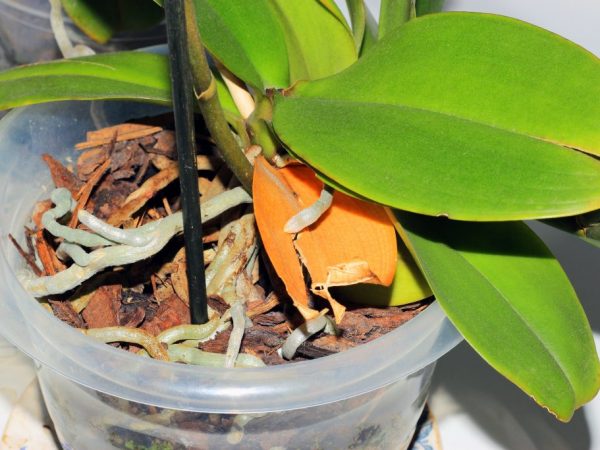Why does the orchid turn yellow
Orchids are moderately demanding to the conditions created for them, many factors affect the growth and development of the flower. There are a number of reasons why an orchid turns yellow. It is possible to save flower stalks and prevent the spread of infection further, the main thing is to start treatment of the plant in a timely manner.

Causes of yellowing orchids
Lighting
Without good lighting, the home orchid will be deprived of the opportunity to bloom. The lack of lighting is manifested by the blanching of the upper roots, it can be easily eliminated - move the phalaenopsis to a brighter place. If dark spots are found, then the plant has received a sunburn due to direct sunlight. Cut off the affected area at the very base, and rearrange the orchid itself in the shade.
Watering
- Poor watering quality is the first cause of poor health. Do not use hard water filled with excess salts and metals. If the cause of the plant's painful condition is this, then the lowest leaves of the orchid are the first to turn yellow, and all subsequent ones will be covered with yellow spots. If the plant is dormant, it is urgent to transplant it into a new substrate. If flowering is in full swing and transplanting is not possible, water the plant with diluted 50/50 distilled water and ordinary settled from top to bottom.
- Lack of moisture - check the soil regularly, if it dries, put the flower pot in a large container of water for 30 minutes, then let the water drain completely and return the phalaenopsis to its original place.
- Excessive watering will lead to decay of the roots, their lethargy, weeping spots will appear and soon the leaf will disappear. If an overflow occurs and the root rots, then the orchid should be transplanted into a new substrate, while removing the damaged areas, but first wait for it to bloom.
Fertilizers
If a previously healthy indoor orchid has turned yellow and dried out, an oversupply of fertilizer may be the cause. When the stem and flowers wither, and the leaf falls off, you can save the phalaenopsis. To do this, rinse the substrate or transplant the flower, you cannot feed the next few months, after that - only with diluted fertilizer.
If only the tips or lower leaves have turned yellow and wrinkled, then the orchid suffers from an excess of calcium. Change the substrate. In this case, for a while, the need for feeding disappears. If the orchid turns yellow on top, veins appear on the leaves and over time they crumbled, then the reason is a lack of potassium - use a special fertilizer.
Diseases
The orchid dries up from fungal infections, they arise with frequent watering and affect the root system and stem of the flower. If rotting is not stopped in time, it will also hit the leaves, causing them to turn yellow and fall off. It is necessary to take immediate action - replace the substrate, cut off the affected areas and treat Phalaenopsis with an antifungal drug. For prophylaxis, use fungicides.
Due to bacterial infections, the leaves turn yellow sharply, darken over time, become lethargic and wrinkled, weeping spots appear with an unpleasant rotten smell. Isolate the plant, trim off affected areas, and iodine the sections. Only after treatment with an antifungal drug can the flowerpot be returned to its original place.
Pests
Most of all, ticks and white-winged moths love orchids. Due to the defeat of the mite, the roots and trunk of the plant receive less nutrients and moisture, the leaves react first, they turn yellow and lose their elasticity. To save a flower, treat it with a special preparation and, after completing a full course of spraying, transplant it into a new substrate. When a whitefly appears, the flower covers a white fine-grained bloom, the leaves quickly wither and fall off, the peduncles can dry out. To restore the leaves, use a soapy solution, it will remove plaque, then spray it with a special solution from pests. The procedure is repeated for several weeks in a row, until complete recovery.
Age

Old leaves may turn yellow and fall off
The leaves may turn yellow and fall off due to old age, but in their place, new, young, light green leaves will surely grow. Usually, the process starts from the lowest leaves, gradually climbing up the stem of the flower. There are also phalaenopsis hybrids that shed their foliage in order during flowering.
Cramped pot
If the orchid is withered and sickly, unfavorable growing conditions may also be the cause.
When the plant has grown and most of the roots are already outside the pot, or are squeezed in it, the roots are deformed and dry, the penetration of moisture and nutrients is difficult, as a result, the leaves turn yellow and begin to fall down. Transplant the phalaenopsis into a pot of a suitable size, dividing it if necessary, try not to damage the buds and peduncles. After transplanting, the plant will quickly bounce back.
Stress
Orchids are delicate and capricious, sensitive to any changes. Changing lighting and temperatures, or moving to a new location is stressful. If it turned yellow and fell off after the above changes, no need to guess why the flower has dried up. The flower should get used to stressful situations gradually - move the pot to a new place for a couple of hours, then return it back.
The homeland of the flower is the tropics, hence such a love for a humid environment. Dry air will provoke yellow leaves, dry tips and dropping. To revive it, provide the right level of moisture with a humidifier or frequent spraying, and the flower will quickly return to normal. If the soil is dry, rinse it under running water.
Prophylaxis
- good substrate;
- illuminated place without direct sunlight;
- watering as the soil dries up with settled water at room temperature;
- a pot of a suitable size;
- fertilizers according to the instructions;
- timely treatment of infections and getting rid of pests.
Care advice
If the rules of care are followed, but the orchid dries up anyway, try to adopt the following tips:
- Alternate the watering method - immerse in a large container of water, and next time water from above, avoiding the lower leaves and trunk.
- Spray the flower regularly with warm water.
- If the roots are bright green - there is enough moisture in the substrate, if they have brightened, the steel is silvery - urgently water, the soil dries.
- After flowering, do not cut the peduncles at the root, if they have not dried up - leave them alone, after a while, carefully trim dry areas.
- Use a special orchid soil that contains pieces of bark.
- Cover an earthen ball with moss, this will protect it from drying out and retain moisture inside the pot.
- The orchid is transplanted only during the dormant period, until the bulb appears, and the peduncle has dried up.
If phalaenopsis does not bloom for a long time, place it in a dark room, later returning it to its place.A contrast shower also helps - warm water first, then cool water. Soon she will delight you with a young arrow.
Conclusion
Whatever is the reason for the yellowness on the leaves, this is a cause for concern and an alarming signal. If you do not react in time, the plant will die. Provide your orchid with proper care and it will surely delight you with long and lush bloom.


